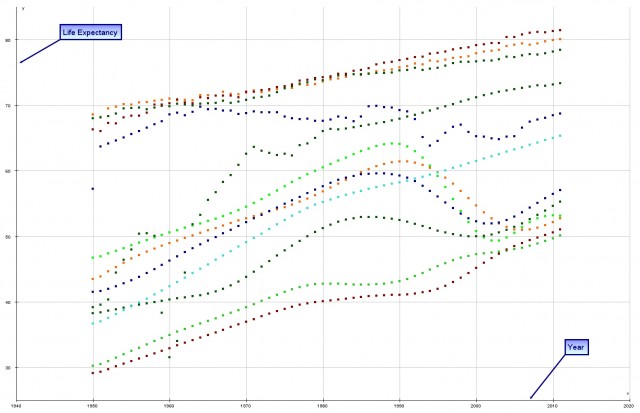AIDS-HIV Statistics

'How have AIDS and HIV affected life expectancy around the world?'
#WorldAIDSday 2014 , Mon 1st December worldaidsday.org
This activity involves a study of eight different countries. You are given eight bits of information about them but you you don't know which bit of information goes with which country. The challenge is to sort the data cards in to a pile for each of the eight different countries! In doing so you will have to look at how life expectancy has changed over the last 60 years, the number and % of people living with HIV, the population and the ratio of people with, to people without, HIV in those countries. The main aim is get the statistics to tell you a story about how AIDS and HIV have affected some different countries around the world. You will need to use and polish your skills in interpreting graphs and data and working with ratio and percentages! The graph below gives a little hint about the nature of the activity. It shows how life expectancy has varied over the last 60 years in a number of different countries. Why do the graphs have those shapes?
The graph below gives a little hint about the nature of the activity. It shows how life expectancy has varied over the last 60 years in a number of different countries. Why do the graphs have those shapes?

Resources
Match up the stats!
You will need all the ![]() AIDS-HIV data cards for this activity. There are eight pieces of information about eight different countries here. The task is simply to sort them in to the right groups for each of the different countries. The solutions are here on the
AIDS-HIV data cards for this activity. There are eight pieces of information about eight different countries here. The task is simply to sort them in to the right groups for each of the different countries. The solutions are here on the AIDS-HIV Statistics teacher notes page. All of the data for this activity and some of the graphs have come from
![]() Gapminder.
Gapminder.
Description
- Students are given the data cards and asked to sort them in to eight different groups. One group for each of the countries in the exercise.
- Students should reason with each other and with the class about the choices they have made.
- Students could move around the room to compare the answers that different groups have.
- The solutions should be shown to the class.
- A discussion should take place where students share what they might have thought/discovered about HIV infections around the world on the basis of this activity.
